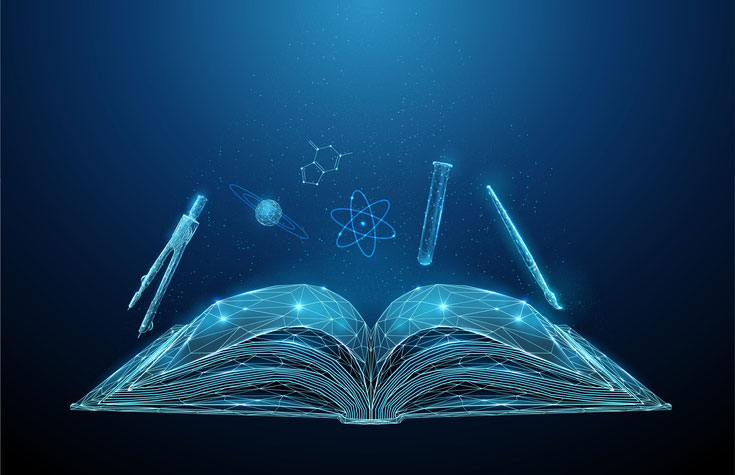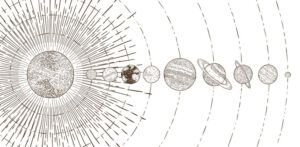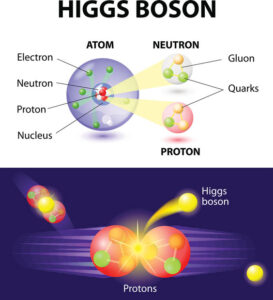

The field of physics has a reputation for being a hard science that describes mechanics, or a math-heavy subject shrouded in theoretical concepts. True, it is those things, but it’s also a field that is perfectly at home within the context of a liberal arts education.
Physics describes where we come from, who we are, and where we’re going; all topics that are central to the liberal arts. Art, music, and philosophy all strive to address those same questions, but they do it from a cultural perspective rather than a scientific and mathematical one. Physics and the liberal arts actually represent two sides of the same coin.
What is Physics?
Physics is the rule book for how matter and energy behave and interact across space and time, and this book is far from being complete. Historically, it seems that for each question that physics answers, a dozen more surface with increasing layers of complexity baked in:
- Courses on the theory of relativity provide insights into the Big Bang, the moment the universe came into existence, including the matter and energy that we are made of. The Big Bang is the theoretical answer to the question about where we came from.
- Courses on electricity and magnetism explain how the modern world around us works.
- Courses on waves and optics explain how we see and interpret the reality we experience.
- Courses on quantum physics offer ideas for an exciting future. Today quantum physics is making fascinating inroads into the true nature of the universe and what we’re made out of.
The answers that physics provides to humanity’s most basic questions have profound implications that overlap with philosophy and religion. Once all matter and energy can be explained as mathematical reactions, does that destroy the concept of free will? Quantum physics says that the building blocks of atoms can exist in multiple places at once. Does that mean we’re blind to the true nature of reality, or that there are multiple realities?
These questions illustrate why the liberal arts are an ideal companion for physics, both for the present and the past.
The History of Physics is a Story Best Told By the Liberal Arts
 Physics is a cumulative development of humanity that’s taken place generation after generation, civilization after civilization. Contributions have been made from cultures across the world and continue right up through the present. Culture, language, religion, and philosophy have been instrumental in preserving the gains made in physics over the millennia.
Physics is a cumulative development of humanity that’s taken place generation after generation, civilization after civilization. Contributions have been made from cultures across the world and continue right up through the present. Culture, language, religion, and philosophy have been instrumental in preserving the gains made in physics over the millennia.
Physics started when humans first looked up at the stars and wondered why the planets moved the way they did. This paved the way for geometry and planted the seeds for mechanics. The Babylonians and Mayans were some of the best ancient astronomers.
Reflecting on the laws of motion of celestial objects sheds light on concepts like mass and energy. The Classical Greek Archimedes is famous for his eureka moment realizing how to calculate density using water displacement.
During the Islamic Golden Age significant strides were made in optics with glass lenses. This opened the door for a better understanding of light and the invention of the compound microscope, a tool that would revolutionize science.
By the seventeenth century, the pieces were in place for the birth in earnest of classical mechanics, also referred to as Newtonian mechanics after the English theologian Isaac Newton. Up until then mathematics had been able to describe things like the motion of everyday objects and the observed behavior of the planets piecemeal. Newton combined both into the unified field of classical mechanics.
Around this time, observations of heat, temperature, and work were unified by the establishment of the field of thermodynamics. Electrodynamics, which would pave the way for the understanding of the electromagnetism, was also ushered in.
Finally, by the 20th century all the pieces were in place for Einstein to bring understandings of energy, mass, and gravity under one roof with his theories of general and special relativity.
Could We See a Unified Theory of Physics in Our Lifetime?
 The theories of relativity were accurate enough to make the beginning of the nuclear age possible, but it may not be the end of the story. Advances in quantum physics seem to represent a new chapter, with concepts already being applied to develop quantum computing power capable of simultaneous binary functions that can crunch through untold zettabytes of data faster than ever believed possible.
The theories of relativity were accurate enough to make the beginning of the nuclear age possible, but it may not be the end of the story. Advances in quantum physics seem to represent a new chapter, with concepts already being applied to develop quantum computing power capable of simultaneous binary functions that can crunch through untold zettabytes of data faster than ever believed possible.
Every day, the field moves closer to developing a unified theory that will combine general relativity with quantum mechanics in a new phase of physics that is already being referred to as the theory of quantum gravity.
Thanks to the knowledge that’s been accumulated and passed down to us from the moment human history began, physics has been able to reach marvelous achievements that have helped the past catch up with the present at astonishing speed. This trajectory can be richly understood in the broader context of the liberal arts.
And while some future developments are predictable, there are many others that aren’t. To start with, the vast majority of the substance that makes up the mass-energy of the universe is unknown. All the stars, galaxies, and everything else that we understand as being normal matter, plus their energy outputs, only account for about 5 percent of the universe’s mass-energy. The rest is comprised of theoretical dark matter (26 percent) and dark energy (68 percent).
There’s still no complete quantum gravity theory that accounts for the discrepancies observed between the laws of general relativity and the laws of quantum physics.
These open mysteries are exciting challenges for anyone involved in this field, but solving them may take us into uncomfortable territory about the true nature of our reality and existence.
Modern Applied Physics Is Making the Here and Now an Amazing Time to Be Alive
 Though they seem like historical figures, people like Newton and Einstein are present in our every-day lives.
Though they seem like historical figures, people like Newton and Einstein are present in our every-day lives.
Atomic clocks are based on principles from atomic physics and electromagnetism. They allow for highly accurate timekeeping, which makes things like GPS possible. GPS itself is made possible by satellites circling the earth which adhere to the orbital mechanics laws established by Newton. Einstein’s theory of special relativity says that fast-moving objects like satellites will experience time dilation relative to an atomic clock on earth, and therefore GPS systems factor in time dilation when they accurately pinpoint a location.
The semiconductor is based on principles of electromagnetism and takes advantage the conductive and resistance properties of different substances, commonly silicon. It’s a type of transistor and as such can be considered an electrical switch that’s either on or off. Until the invention of the semiconductor transistors were made of vacuum tubes, glass jars that resemble light bulbs, which had a tendency to break and were hard to miniaturize. The advent of the silicon transistor meant that these on-off switches could be miniaturized, making it easier to combine many together and create complex systems of electrical gateways.
Today this has led to our modern world where our lives depend on computers. Modern computer chips cram 50 billion transistors into an area that’s about two square inches.
Computers and by extension physics have revolutionized the way we perceive the world and communicate with each other. GPS has made it easier than ever to travel anywhere and not get lost. It’s more important than ever to keep these radical changes within the context of the liberal arts so we’re continually reminded what it means to be humans who are part of a larger culture and society.
And this holds equally true going forward into the future.
Applied Physics Will Carry Forward the Liberal Arts Tradition of Pushing the Potential of Humanity
The ramifications of quantum physics mean that reality as we know it does not exist, and that Einstein’s theory of relativity is incomplete. It was in refuting this assertion that Einstein famously said, “God does not play dice.” However, quantum physics has since been proven to hold great potential for mankind, and continued scientific enquiry into physics.
Cures for virtually all diseases and answers to some of science’s biggest questions may be just around the corner with advancements in quantum physics.
Quantum computers have already been developed though they’re still far from harnessing the full advantages of quantum properties. But their potential is huge.
Whereas silicon semiconductors incorporate billions of on-off switches, the binary 1s and 0s of a computer’s language, quantum computers add a third option to each semiconductor. Once this is perfected, the number of calculations a computer can do per second will vastly increase, potentially making all the following possible:
- Complex simulations of scientific and mathematical equations that will solve some of the most pressing issues in these fields.
- Protein folding simulations that will enable medicine to be developed to combat virtually all diseases.
- Complex climate simulations that will be able to predict the weather with greater accuracy over a longer time period.
But like any new technology, quantum computers can be a double-edged sword. The increase in computing power will likely mean that whoever unlocks the full potential of quantum computing first will be able to brute-force crack any encryption key, making all information on the internet vulnerable to decryption.
Physics dictate the rules for how the universe behaves, and anyone who can fully wield those rules for their own advantage would possess the powers to play any game of dice they wish. That’s why it’s important to ground the study of physics in what it means to be a part of the story of humanity.




